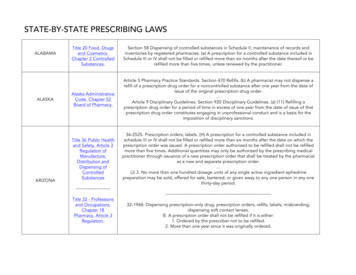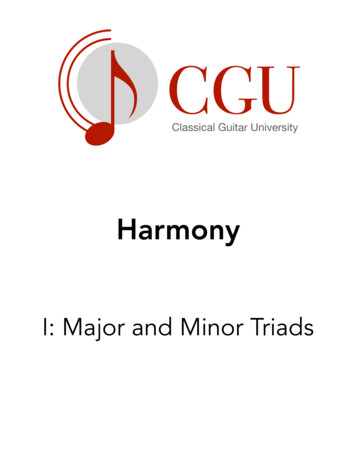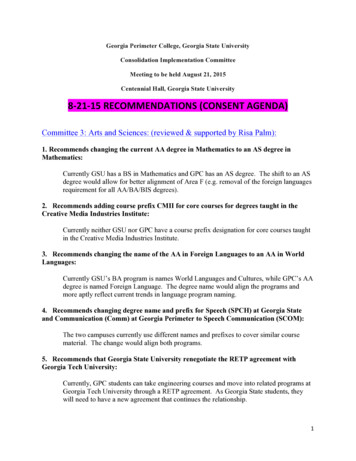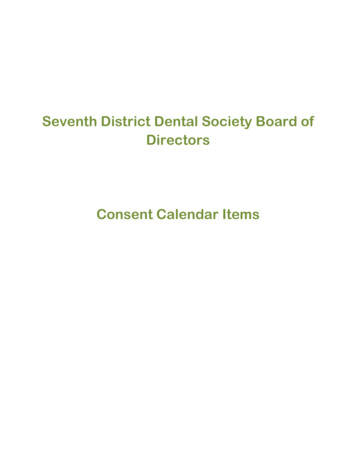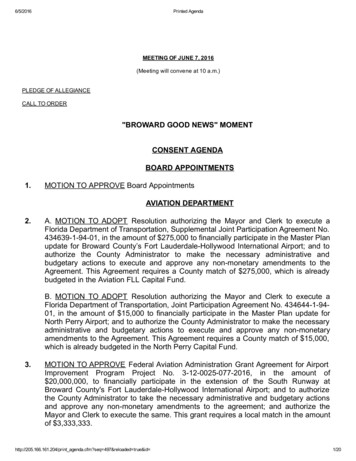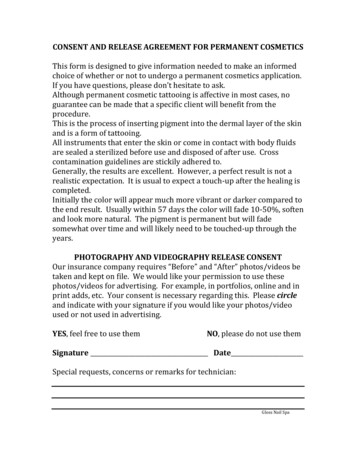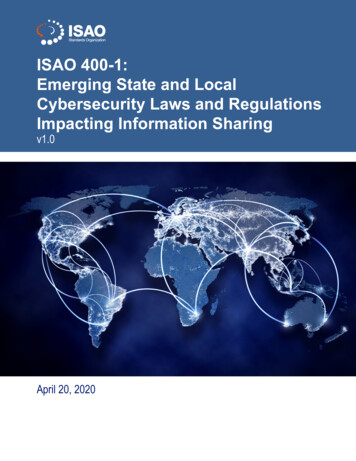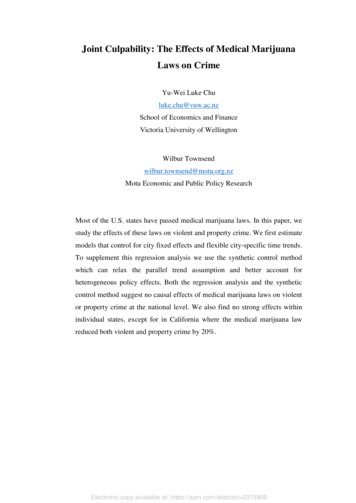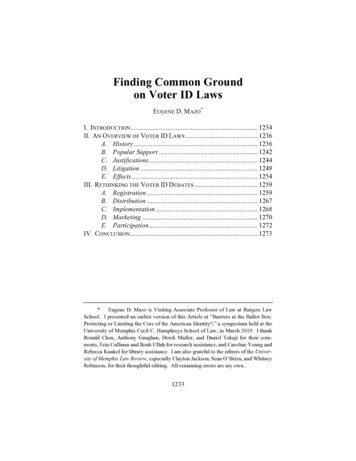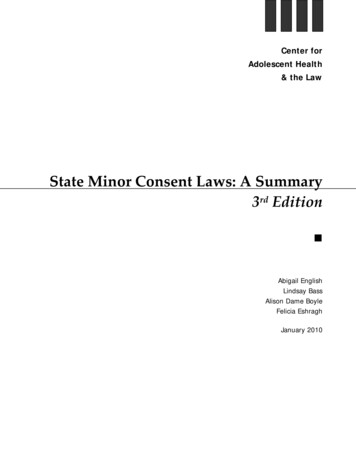
Transcription
Center forAdolescent Health& the LawState Minor Consent Laws: A Summary3rd Edition Abigail EnglishLindsay BassAlison Dame BoyleFelicia EshraghJanuary 2010
2010 Center for Adolescent Health & the Law. All rights reserved.Support for this publication was provided by the North Carolina Division of Public Health and the Centersfor Disease Control and Prevention, through a contract with the University of North Carolina, Chapel Hill.Additional support was provided by The Brush Foundation, The George Gund Foundation, The ComptonFoundation, GlaxoSmithKline, the Moriah Fund, and the generosity of individual donors. The content ofthe publication is the sole responsibility of the authors and the Center for Adolescent Health & the Law.Cover Design by Alison DuncanLayout by Amy StinnettISBN: 0‐9744108‐2‐9DisclaimerState Minor Consent Laws: A Summary, 3rd Edition (2010), is made available for informational purposes onlyand does not constitute legal advice or representation. For legal advice, a practicing attorney who hascomprehensive knowledge of all relevant laws – federal, state, and local – and who has been informed of allrelevant details of the situation should be consulted.The authors have attempted to assure that the information presented is accurate as of the date ofpublication. The Center for Adolescent Health & the Law and the authors do not guarantee the accuracy ofthe contents of this monograph. Laws change frequently and interpretations of laws vary from court to courtand among legal authorities. New statutes may have been enacted, new regulations promulgated, or newcases decided after this monograph was finished. The last comprehensive verification of the information inthis monograph was completed in August 2009.The Center for Adolescent Health & the Law and the authors specifically disclaim any liability for loss orrisk incurred as a consequence of the use and the application, either directly or indirectly, of any material inthis book.Center for Adolescent Health & the LawPhone: 919.968.8850Email: info@cahl.orgWebsite: www.cahl.org
AcknowledgmentsThe Center for Adolescent Health & the Law gratefully acknowledges the extensive assistance received froma wide variety of friends and colleagues who have supported the Center’s work and the preparation of StateMinor Consent Laws: A Summary, 3rd Edition. Without their help this publication would not have beenpossible.The first edition of this monograph, State Minor Consent Statutes: A Summary (1995), was produced under theauspices of the National Center for Youth Law in San Francisco, California. The initial research for thesecond edition of the monograph was completed while the Center for Adolescent Health & the Law was aproject of Advocates for Youth in Washington, DC. The second edition was published in 2003 by the Centerfor Adolescent Health & the Law and was co‐authored by Abigail English and Kirsten Kenney, withextensive assistance from Madlyn Morreale and Amy Stinnett.Many individuals provided valuable encouragement, insights, advice, and information during the planning,research, and writing of this third edition of the monograph. In particular, the resources of the NationalCenter for Youth Law, the Guttmacher Institute, the ACLU Reproductive Freedom Project, and the PlannedParenthood Federation of America were especially helpful. Amy Stinnett, Deputy Director of the Center forAdolescent Health & the Law, and numerous legal research assistants, fellows, and interns working at theCenter provided extensive support throughout the development of the third edition. We are also indebtedto many other individuals and organizations on whose work we relied in resolving questions and assuringthe accuracy of information in this monograph.
State Minor Consent Laws: A Summary3rd EditionTABLE OF CONTENTSPreface1Introduction2State ornia30Colorado37Connecticut43Delaware49District of sota137Mississippi143Missouri148Montana153Center for Adolescent Health & the LawChapel Hill, North Carolinawww.cahl.orgiiJanuary 2010
State Minor Consent Laws: A Summary3rd EditionTABLE OF CONTENTSState SummariesNebraska159Nevada163New Hampshire168New Jersey173New Mexico178New York184North Carolina190North 8Rhode Island223South Carolina227South inia254Washington259West Virginia264Wisconsin268Wyoming273AppendicesJanuary 2010Appendix A – Minor Consent for Health Care: A Chart of State Laws288Appendix B – Selected Resources on Consent & Confidentiality291Appendix C – Selected Resources on the HIPAA Privacy Rule294Appendix D – Selected Resources on Minors and Abortion296Center for Adolescent Health & the LawChapel Hill, North Carolinawww.cahl.org
State Minor Consent Laws: A Summary3rd EditionPREFACEState Minor Consent Laws: A Summary 3rd Edition, summarizes the laws in each of the 50 U.S. states and the District ofColumbia that allow minors to give their own consent for health care. A brief overview of the laws in each jurisdiction isprovided. The laws summarized for each jurisdiction are divided into two groups: laws that are based on the status of theminor; and laws that are based on the type of health care the minor is seeking.When a law was found that expressly allows a minor who has a certain status or who is seeking a specific type of care togive his or her own consent, that law was summarized. In addition, when the provisions of some other law areparticularly relevant to understanding or applying the consent laws, a reference to that other law was included wheneverpossible.When no law was found expressly authorizing minors to give their own consent for care, the reader is referred to theIntroduction, which contains discussion of the broad legal framework that is relevant to consent and confidentiality inadolescent health care. The Introduction also includes discussion of the specific implications for delivering services whenthe law in a particular state does not contain an express authorization for a minor to consent.For each state, the overview of the laws is followed by a chart in which a “9” is used to indicate for each topic whether arelevant law was found and whether minors are authorized to consent. In some instances, a “9” is included even if thereis not an explicit statute authorizing minors to consent based on the particular status or type of care but that authority canbe informed by other laws. The purpose of the chart is to provide a quick view of whether the state has a large number ofminor consent laws and related provisions, or whether the frequency of these laws in the state is sparse, as well as anindication of the circumstances in which minors can consent for their own care. Citations of the laws found are includedin the chart, along with cross references to the Introduction and to other relevant laws in the state.Appendix A contains a table that indicates for each state and each status and service category whether there is a basis forminors to give their own consent for care. Appendix A does not include all the details that are contained in the summariesand should not be relied on in lieu of the summaries. Appendices B, C, and D, respectively, contain information aboutgeneral resources on consent and confidentiality, the HIPAA Privacy Rule, and abortion.In preparing the monograph, comprehensive research was done to identify the laws in each state that allow minors togive their own consent for health care (or that specifically limit their ability to consent). This research was conductedusing the online legal databases of Lexis and Westlaw, supplemented by searches of other Internet sources, printedlibrary materials, and direct inquiries to knowledgeable experts. The information was verified using Lexis and Westlawduring August 2009 and changes in state laws that took place through the end of that month were included. In addition,the information was cross‐checked against other published and unpublished materials detailing state minor consent laws.Prior to publication of the second edition of the monograph, the U.S. Department of Health and Human Services issuedbroad federal medical privacy regulations (known as the HIPAA Privacy Rule). In delineating the scope of protection forthe privacy of minors’ health information, the HIPAA Privacy Rule relies heavily on the state minor consent laws andother laws. Therefore, the minor consent laws for each state were reviewed to determine whether they contain specificprovisions relevant to the confidentiality or disclosure of information about the services for which minors may giveconsent. Whenever such provisions were found, they were included in the summary. State medical privacy laws thatspecifically reference or rely on the minor consent laws also were cited and summarized whenever possible. However, themonograph does not contain comprehensive information about all state laws pertaining to medical privacy andconfidentiality of health information. The reader is referred to other sources for such information.For most states, a variety of other laws were identified that have direct relevance to consent and confidentiality in thedelivery of health services for adolescents who are minors. These laws addressed such topics as the right of a health careprofessional to rely in good faith on information about a minor’s status, financial responsibility for care when a minormay consent, and authorization for minors to receive sexual assault services without parental consent. A comprehensivesearch of every state’s laws for these provisions was not conducted, but whenever these provisions were identified theywere included in the summary.State Minor Consent Laws: A Summary, 3rd Edition, is part of an ongoing series of publications and written materials,including journal articles, book chapters, fact sheets, issue briefs, and charts on consent and confidentiality published bythe Center for Adolescent Health & the Law.January 20101Center for Adolescent Health & the LawChapel Hill, North Carolinawww.cahl.org
State Minor Consent Laws: A Summary3rd EditionINTRODUCTIONIntroductionnumerous exceptions to this basic rule allowcare to be provided without the consent of aparent.This introduction provides background informationon the laws that form the legal framework forconsent and confidentiality in adolescent healthcare. It is not intended as a comprehensive analysisof all relevant laws, rather as a preliminary guide tothe context in which the state minor consent lawsthat are the subject of this monograph exist. A list ofrelevant background references is included at theend of this introduction, and several appendices areat the end of the monograph, both of which amplifythe information provided in the introduction.The Legal FrameworkThe legal framework for consent and confidentialityin adolescent health care includes both state andfederal laws. These laws are embodied inconstitutional doctrine, statutes enacted by Congressand state legislatures, regulations promulgated byadministrative agencies at all levels of government,and cases decided by courts. Notable fordetermining the consent requirements foradolescents to receive health care are the statutesknown as “state minor consent laws” that are thesubject of this monograph. Of similar importance forthe confidentiality of adolescents’ health informationare the federal medical privacy regulations knownas the “HIPAA Privacy Rule.” Many other laws havegreat significance in specific circumstances as well,such as statutes providing for the emancipation ofminors, court decisions delineating the matureminor doctrine, regulations protecting adolescents’confidentiality in family planning and substanceabuse programs, and court decisions interpreting theconstitutional right of privacy.Consent for Health CareWhen an adolescent seeks health care, consent forthe care must be given by someone with theappropriate legal authority. Adolescents who areover the age of majority are adults and can give theirown consent for health care. For an adolescent whois under the age of majority the consent of a parentor a legal guardian is generally required. However,Center for Adolescent Health & the LawChapel Hill, North Carolinawww.cahl.org2Depending on the specific circumstances,consent for a minor’s care may be provided by alegal guardian, a court, or even a foster parent orother adult caretaker. Also, in emergencies, caremay be provided without the prior consent of aparent, although the health care provider isusually required to inform the parent as soon aspossible. For the purpose of this monograph, themost relevant exceptions to the requirement ofparental consent are those that allow minors togive their own consent for care.Minor ConsentThe laws that authorize minors to give their ownconsent for health care are mostly state laws.Beginning in the middle of the 20th century,states began to enact specific statutes to enableminors to obtain care without parental consent.Over the next half century, every state enactedsome of these statutes, which are generallygrouped into two broad categories: laws that arebased on the status of the minor; and laws thatare based on the type of care they are seeking.The summaries in this monograph are organizedbased on these two broad classifications.Within each of these broad categories some ofthe laws contain additional variations. Forexample, a law may contain one or more of thefollowing elements: an age limit, a limit on therange of specific services covered, orenumeration of the providers or sites that maydeliver the care. In addition, a law may contain astatement that a physician or other health careprofessional may rely in good faith onrepresentations made by the minor that he orshe is legally allowed to consent. Also, a lawmay specify whether the parent or the minor isfinancially responsible for payment when theminor consents. Finally, a law may includespecific provisions regarding whetherinformation about the care for which the minorconsents may be disclosed to parents orguardians.January 2010
State Minor Consent Laws: A Summary3rd EditionINTRODUCTIONMature Minor Doctrinewhich states have laws expressly allowingminors to consent for health care are:emancipated minors; minors who are livingapart from their parents; minors who aremarried; minors who are pregnant; and minorswho are parents. In addition, there are othercategories in which a small number of stateshave laws allowing minors to consent for healthcare such as minors who are in the military orminors who are incarcerated.The concept of the “mature minor” is familiar tomany health care professionals who treatadolescents, but its origin and meaning are notalways well understood. The mature minor doctrinedeveloped as part of the common law in courtdecisions. Generally, according to the mature minordoctrine, a physician is not liable for providing carewithout parental consent when the care is within themainstream of medical opinion, is not high risk, andis provided in a non‐negligent manner, as long asthe minor is an older adolescent who is capable ofgiving informed consent to the care and doesconsent.Emancipated minors are widely considered tohave attained full or partial adult status and tobe authorized to consent for their own healthcare. The concept of an emancipated minororiginated in the common law and dates back toColonial times. Historically, the criteria forrecognizing a minor as emancipated weremarriage, military service, or living apart fromparents and being self‐supporting. Although theconcept of the emancipated minor wasoriginally developed by the courts, numerousstates have enacted statutes recognizingemancipated minors and establishingprocedures for determining that a minor isemancipated. Some of the early statutes weredesigned primarily to allow a minor to conductspecific transactions, such as buying and sellingreal property or entering into contracts. Statutesenacted more recently often specify that alegally emancipated minor, who has met thestatutory criteria for emancipation and receiveda court declaration of emancipation, mayconsent for health care. At least 37 states haveenacted statutes that expressly authorizeemancipated minors to consent for health careor specify that emancipated minors have adultstatus. In other states, however, minors whomeet traditional criteria for emancipation shouldalso be recognized as able to consent for healthcare. This monograph provides information foreach state about whether it has a statute thatauthorizes emancipated minors to consent forhealth care or specifies that they have adultstatus.The doctrine has been expressly accepted orfavorably discussed by courts in several states.Many fewer states have expressly rejected thedoctrine’s validity. The doctrine is sometimes reliedon as a justification for accepting the informedconsent of mature minors for health care, even instates where courts have not expressly accepted thedoctrine.The concept of the mature minor has also beenacknowledged, although without much specificdefinition, in U.S. Supreme Court cases ruling onrequirements for parental notification or consent fora minor to obtain an abortion. It is also oftenmentioned in court cases addressing the right of aminor to obtain an abortion without parentalconsent or notification through a state’s judicialbypass procedure.Only a few states have incorporated the matureminor doctrine into a statute. A small number ofstates have enacted statutes that, for example, allowminors to give their own consent for care if theyhave “sufficient intelligence to understand andappreciate the consequences of the proposedsurgical or medical treatment or procedures,” usingthat or similar language. In states where they exist,those statutes are summarized under the heading of“General Medical Care” in this monograph.Consent by Minors Based on Their StatusEvery state has enacted one or more statutesallowing minors to consent for health care based ontheir status. The most common status categories inJanuary 20103Center for Adolescent Health & the LawChapel Hill, North Carolinawww.cahl.org
State Minor Consent Laws: A Summary3rd EditionINTRODUCTIONMinors who are living apart from their parents maybe expressly authorized to consent for their ownhealth care, even if they do not meet the criteria forlegal emancipation and have not received a courtdeclaration of emancipation. At least 26 states allowminors who are living apart from their parents toconsent for their own health care either because anexplicit statute authorizes them to do so or becausethe state allows minors to consent for generalmedical care. Some of the statutes that authorizeminors who are living apart to consent include oneor more additional specific criteria such as an agelimit or a requirement that the minor beindependent of parental support. However, severalof the statutes also contain specific criteria designedto broaden access for these young people, such as astatement that the minor may consent regardless ofthe source of his or her income, regardless of thelength of time he or she has lived apart fromparents, or regardless of whether the young personis living apart from parents with or without parentalpermission. This monograph provides informationfor each state about whether it has a statute thatauthorizes minors who are living apart from theirparents to consent for health care.are parents to consent for health care forthemselves or their children or both. Even in theabsence of a statute, minors who are parentsmay be able to consent for health care forthemselves on some other basis: because theyare emancipated, or living apart from theirparents, or married, for example. Also, even inthe absence of a statute, on the basis of
Acknowledgments The Center for Adolescent Health & the Law gratefully acknowledges the extensive assistance received from a wide variety of friends and colleagues who have supported the Center’s work and the preparation of State Minor Consent Laws: A Summary, 3rd Edition
